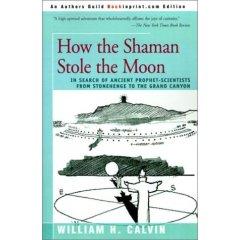| 2020ok Directory of FREE Online Books and FREE eBooks |
Free eBooks > History > Ancient > General > How The Shaman Stole The Moon: In Search Of Ancient Prophet-scientists From Stonehenge To The Grand Canyon
How The Shaman Stole The Moon: In Search Of Ancient Prophet-scientists From Stonehenge To The Grand Canyonby William H. Calvin  Download Book (Respecting the intellectual property of others is utmost important to us, we make every effort to make sure we only link to legitimate sites, such as those sites owned by authors and publishers. If you have any questions about these links, please contact us.) link 1 About Book From Publishers Weekly This provocative, informative yet sometimes dry catalogue sets out to unravel methods used by ancient "prophet-scientists" that may have boardered on the scientific to predict eclipses and seasonal changes. Although the work leaps around without adhering to chronology or building on its own revelations, some individual sections sparkle. Calvin ( The Ascent of Mind ) speculates about Stonehenge, "The three complicated eclipse-prediction schemes for Stonehenge all focus on this eclipse repeat cycle, all use those 56 Aubrey holes in the ring that surrounds (and antedates) the central megaliths or the inner ring of 19 bluestones." The journey continues around the world to such historic wonders as the Grand Canyon and the Anasazi caves of the Hopi Indians. The book may be somewhat technical for lay readers . Illustrations not seen by PW. Copyright 1991 Reed Business Information, Inc. From Library Journal Were shamans in prehistoric cultures able to predict solar and lunar eclipses? Calvin (neurobiology, Univ. of Washington), brings together data from astronomy and archaeology in an attempt to answer this question. Employing research at Stonehenge and Avebury in England, and numerous Anasazi Indian sites in the American Southwest, Calvin concludes that there were over a dozen possible methods of eclipse forecasting that prehistoric people may have used. He admits that his hypotheses on prehistoric astronomical techniques are speculative, and emphasizes that they may only provide a clue to what might have been. Nevertheless, his theories are well thought out and clearly explained. The narrative flows smoothly as the numerous possible methods of prediction are described within the context of the story of his research at the various archaeological sites. This fascinating book should be a useful addition to library popular science collections. - Elizabeth Salt, Otterbein Coll. Lib., Westerville, Ohio Copyright 1991 Reed Business Information, Inc. From Kirkus Reviews Neurobiologist Calvin (The Ascent of Mind, 1990; The Throwing Madonna: Essays on the Brain, 1983) tackles an unlikely subject--archaeoastronomy--and brings to it his scientific training, a lively curiosity, and the ability to describe objects and phenomena clearly. Archaeoastronomy is Calvin's hobby, and he pursues it in Anasazi ruins in the American Southwest and in the remains of Stonehenge on England's Salisbury Plain. Describing a dozen simple methods to predict lunar eclipses that could have been used by ancient peoples, plus a couple of ways to detect an impending solar eclipse, Calvin argues the likelihood that the ability to forecast such celestial events preceded civilization. In doing so, he shows us a scientific mind at work, asking questions, collecting data, revising theories, seeking new evidence. His descriptions of camping out in Arizona's Canyon de Chelly and New Mexico's Chaco Canyon to test and refine his theories are fascinating. He is less successful, however, at explaining what it all means. In what ways did early forecasters- -shamans, prophets, or protoscientists--signal the beginnings of religion and/or science, what powers did they wield, and what roles did they play in shaping their societies? Calvin conjectures freely on these and other questions, tossing out notions and then inexplicably abandoning them, leaving ideas unresolved and the reader up in the air. Perhaps that's his intent, but it's ultimately unsatisfying. One wishes he had spent as much time exploring the significance of archaeoastronomers as he does in persuading us of their probable existence. Still, lively and literate science for the nonscientist. (Fifty-nine line drawings--not seen.) -- Copyright ©1991, Kirkus Associates, LP. All rights reserved. The New York Times Book Review "A high-spirited adventure that wholeheartedly affirms the joys of curiosity." Related Free eBooks
| Related Tags |












SEND A COMMENT
PLEASE READ: All comments must be approved before appearing in the thread; time and space constraints prevent all comments from appearing. We will only approve comments that are directly related to the article, use appropriate language and are not attacking the comments of others.